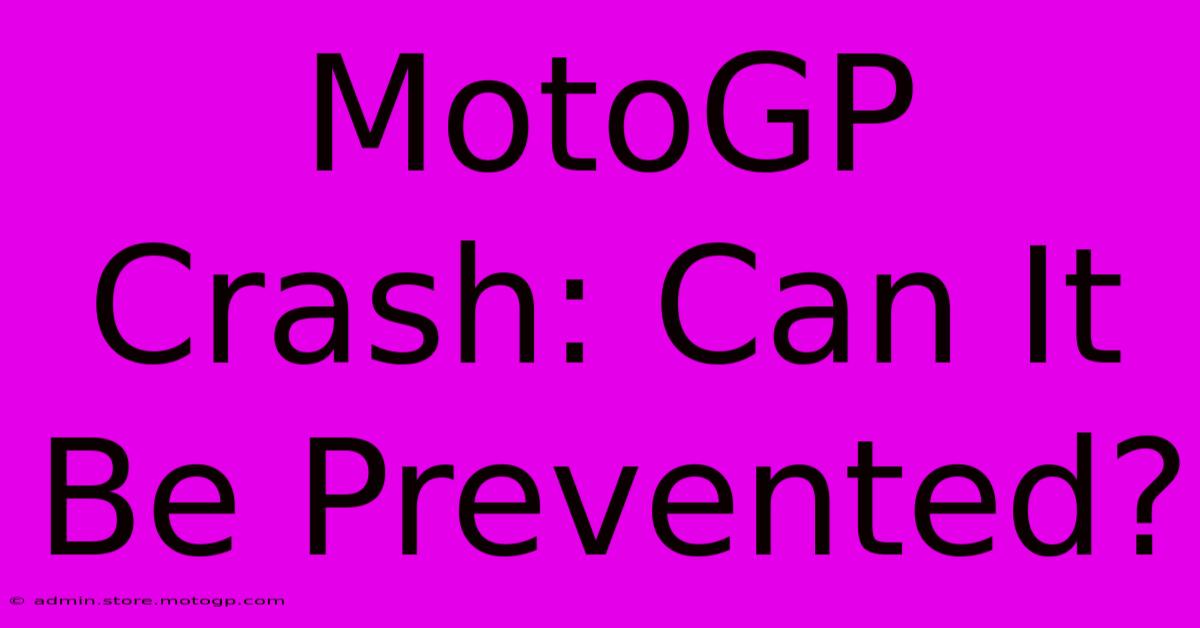MotoGP Crash: Can It Be Prevented?

Table of Contents
MotoGP Crash: Can It Be Prevented?
The roar of the engines, the blur of speed, the breathtaking skill – MotoGP is a spectacle of athleticism and engineering. But behind the glamour lies a stark reality: crashes are an inherent risk. While eliminating them entirely is impossible, significant strides can be made to minimize their frequency and severity. This article delves into the causes of MotoGP crashes, exploring existing safety measures and examining potential future advancements to prevent these high-speed incidents.
Understanding the Causes of MotoGP Crashes
MotoGP crashes are rarely caused by a single factor. Instead, they're often the result of a complex interplay of several contributing elements:
1. Rider Error: The Human Factor
Despite years of training and experience, rider error remains a significant contributor to crashes. This can manifest in various ways:
- Pushing the limits: MotoGP riders constantly operate at the edge of control, pushing their bikes and themselves to the absolute maximum. A slight mistake at these speeds can have catastrophic consequences.
- Loss of traction: Sudden changes in track conditions (oil, water, debris) or aggressive riding can cause the tires to lose grip, leading to a fall.
- Overtaking maneuvers: Close-quarters battles for position often increase the risk of collision, especially at high speeds.
- Physical or mental fatigue: The demanding physical and mental strain of a race can impair judgment and reaction time, increasing the likelihood of an error.
2. Mechanical Failures: When the Machine Fails
While modern MotoGP bikes are marvels of engineering, mechanical failures can still occur:
- Engine problems: Sudden engine failure or loss of power can leave a rider vulnerable, especially during high-speed sections of the track.
- Tire failure: Tire punctures or blowouts are a serious risk, particularly at the speeds achieved in MotoGP.
- Brake failure: Loss of braking power can result in a high-speed crash, as the rider is unable to slow down adequately.
- Electronic system malfunctions: Sophisticated electronic control systems are crucial in modern MotoGP bikes, and malfunctions in these systems can have unpredictable consequences.
3. Track Conditions: External Factors
The track itself plays a significant role in crash prevention:
- Weather: Rain, especially sudden downpours, dramatically alters track conditions, reducing grip and increasing the risk of aquaplaning.
- Track surface: The condition and consistency of the track surface directly impact tire grip.
- Track design: The layout and design of the circuit can contribute to hazardous situations, creating blind corners or overly aggressive changes in elevation.
Existing Safety Measures in MotoGP
MotoGP has implemented numerous safety measures to mitigate the risks of crashes:
- Improved track design: Tracks are constantly being upgraded to improve safety, incorporating larger run-off areas and improved barriers.
- Advanced safety equipment: Riders wear advanced protective gear, including leather suits, helmets, and specialized body armor. Airbags are also increasingly common.
- Medical response teams: Highly skilled medical personnel are stationed trackside, providing immediate medical attention to injured riders.
- Safety innovations in motorcycle technology: Sophisticated electronic rider aids, like traction control and anti-wheelie systems, help prevent crashes by limiting rider error.
Future Advancements in Crash Prevention
Research and development continue to explore new ways to improve safety in MotoGP:
- Advanced rider monitoring systems: Real-time monitoring of rider physiological data (heart rate, fatigue levels) could provide early warnings of potential risk.
- Improved trackside safety systems: The deployment of more advanced barrier systems and run-off area designs could further minimize the impact of crashes.
- Autonomous emergency braking systems: Future motorcycles may incorporate autonomous braking systems that can react to impending crashes faster than a human rider.
- Enhanced data analysis: More comprehensive data analysis could help identify high-risk situations and track sections, leading to proactive changes in track design or rider training.
Conclusion: A Continuous Pursuit of Safety
While completely eliminating crashes in MotoGP is an unrealistic goal, continuous efforts to minimize their frequency and severity are essential. By combining advancements in rider training, motorcycle technology, track design, and safety equipment, MotoGP can continue to strive for a safer environment for its incredibly skilled and courageous athletes. The pursuit of safety remains an ongoing process, constantly evolving in response to the inherent risks of this exhilarating sport.

Thank you for visiting our website wich cover about MotoGP Crash: Can It Be Prevented?. We hope the information provided has been useful to you. Feel free to contact us if you have any questions or need further assistance. See you next time and dont miss to bookmark.
Featured Posts
-
Cota F1 The Home Of Official Merchandise
Feb 18, 2025
-
Moto Gp Streams Cord Cutting Fans Dream
Feb 18, 2025
-
Moto Gp Bikes A Symbol Of Power And Speed
Feb 18, 2025
-
Moto Gp Race Tracks A Global Perspective
Feb 18, 2025
-
Yamaha Moto Gp From Setback To Comeback Team News Analysis
Feb 18, 2025
